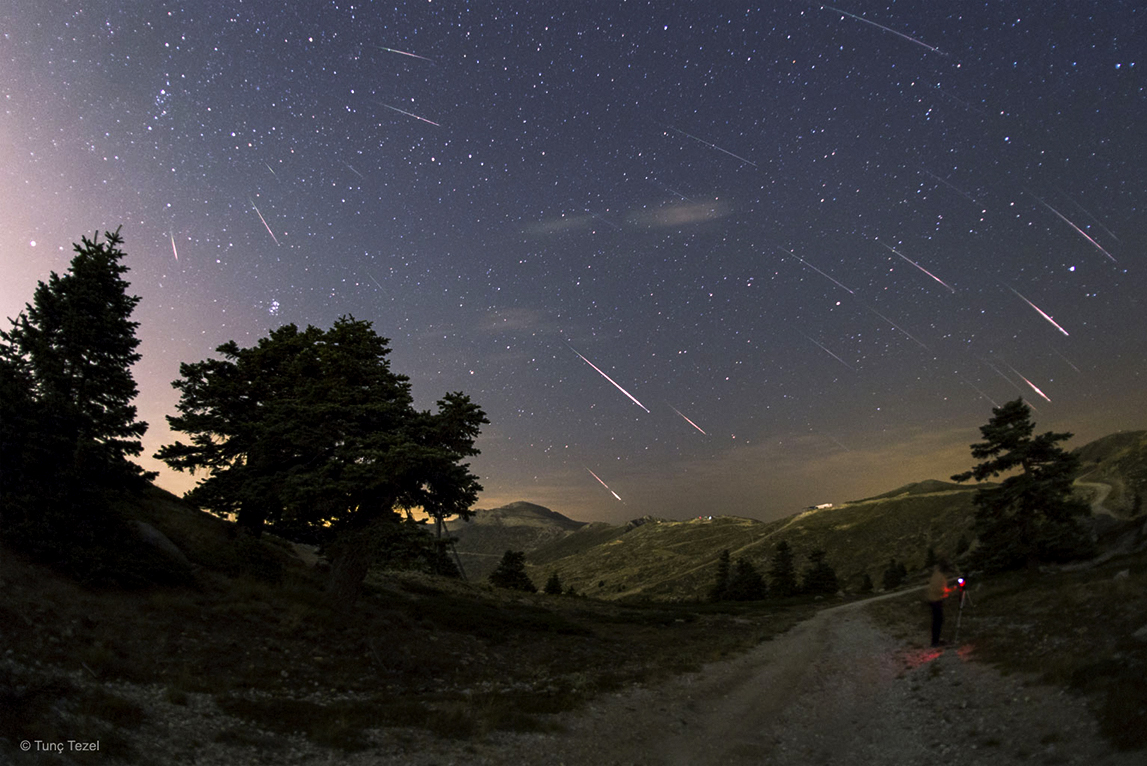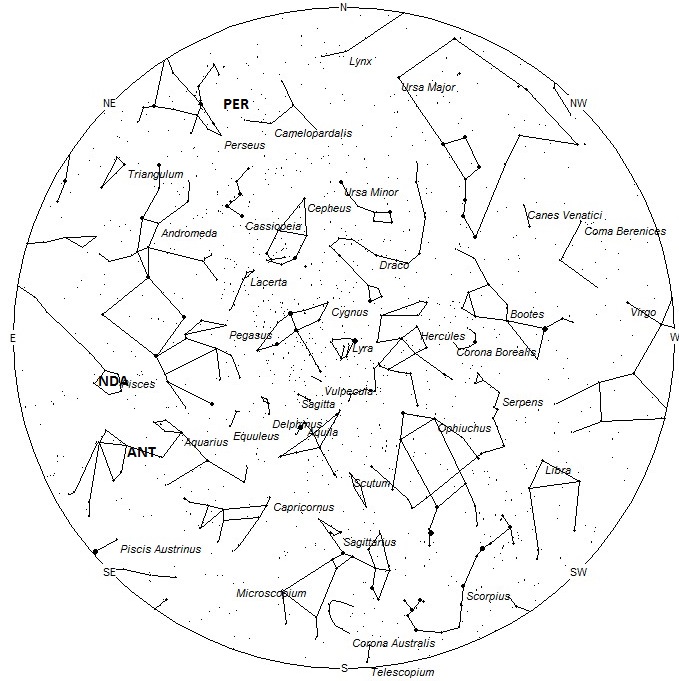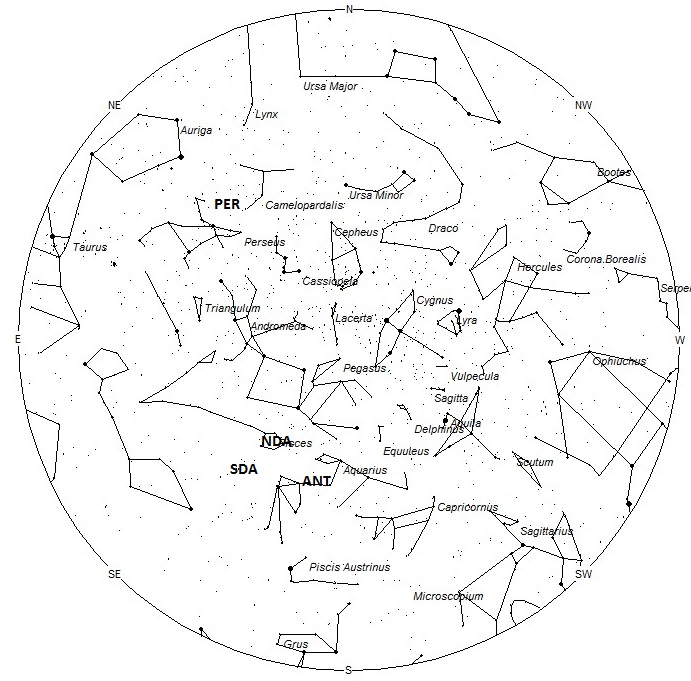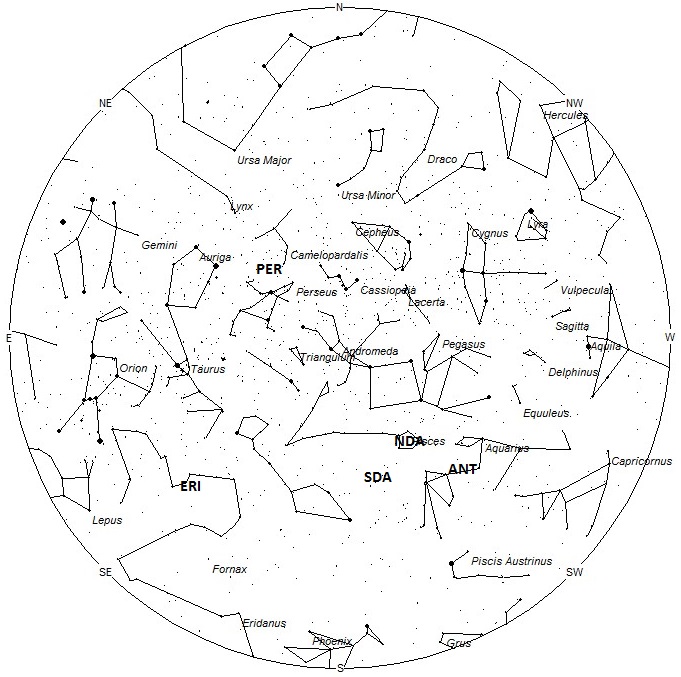
During this period the moon will reach its new phase on Monday August 21st. At this time the moon will be located near the sun and will be invisible at night. As the week progresses the waxing crescent moon will enter the evening sky but will not cause any problems for those viewing meteor activity. The estimated total hourly meteor rates for evening observers this week is near 5 for those viewing from the northern hemisphere and 3 for those located south of the equator. For morning observers the estimated total hourly rates should be near 23 as seen from mid-northern latitudes and 13 from the southern tropics. The actual rates will also depend on factors such as personal light and motion perception, local weather conditions, alertness and experience in watching meteor activity. Note that the hourly rates listed below are estimates as viewed from dark sky sites away from urban light sources. Observers viewing from urban areas will see less activity as only the brighter meteors will be visible from such locations.
The radiant (the area of the sky where meteors appear to shoot from) positions and rates listed below are exact for Saturday night/Sunday morning August 19/20. These positions do not change greatly day to day so the listed coordinates may be used during this entire period. Most star atlases (available at science stores and planetariums) will provide maps with grid lines of the celestial coordinates so that you may find out exactly where these positions are located in the sky. A planisphere or computer planetarium program is also useful in showing the sky at any time of night on any date of the year. Activity from each radiant is best seen when it is positioned highest in the sky, either due north or south along the meridian, depending on your latitude. It must be remembered that meteor activity is rarely seen at the radiant position. Rather they shoot outwards from the radiant so it is best to center your field of view so that the radiant lies at the edge and not the center. Viewing there will allow you to easily trace the path of each meteor back to the radiant (if it is a shower member) or in another direction if it is a sporadic. Meteor activity is not seen from radiants that are located far below the horizon. The positions below are listed in a west to east manner in order of right ascension (celestial longitude). The positions listed first are located further west therefore are accessible earlier in the night while those listed further down the list rise later in the night.
These sources of meteoric activity are expected to be active this week.
.
The center of the large Anthelion (ANT) radiant is currently located at 22:40 (340) -07. This position lies in central Aquarius directly between the two 4th magnitude stars known as tau 2 and gamma Aquarii. Due to the large size of this radiant, Anthelion activity may also appear from eastern Capricornus as well as Aquarius. This radiant is best placed near 0200 local daylight saving time (LDT), when it lies on the meridian and is located highest in the sky. Hourly rates at this time should be near 2 no matter your location. With an entry velocity of 30 km/sec., the average Anthelion meteor would be of medium-slow velocity.
The Northern delta Aquariids (NDA) are active from July 23 through August 27. The radiant is currently located at 23:32 (353) +05. This position is located in western Pisces, inside the group of faint stars known as the “Circlet”and just 2 degrees southeast of the 4th magnitude star known as theta Piscium. Hourly rates should be near 1 per hour no matter your location. The radiant is best placed near 0300 LDT, when it lies highest in the sky. With an entry velocity of 38 km/sec., these meteors would be of medium velocities. This shower seems to be a continuation of the Northern June Aquilids, which had been active since early June.
The Southern Delta Aquariids (SDA) are active from a radiant located at 00:02 (000) -08. This position is located where the borders of Aquarius, Pisces, and Cetus meet. This area of the sky is also 4 degrees northwest of the 4th magnitude star known as Deneb Kaitos Shemali (iota Ceti). Hourly rates are expected to be less than 1 no matter your location. The radiant is best placed near 0400 LDT, when it lies highest in the sky. With an entry velocity of 41 km/sec., most activity from this radiant would be of average velocities.
The eta Eridanids (ERI) were discovered by Japanese observers back in 2001. Activity from this stream is seen from July 23 though September 17 with maximum activity occurring on August 11. The radiant currently lies at 03:28 (052) -10, which places it in western Eridanus, 1 degree southwest of the 4th magnitude star known as Ran (epsilon Eridani). This area of the sky is best seen during the last dark hour before dawn when the radiant lies highest in a dark sky. Current rates are expected to be near 1 per hour during this period no matter your location. With an entry velocity of 65 km/sec., the average meteor from this source would be of swift velocity.
The Perseids (PER) are active from a radiant located at 03:52 (058) +59. This position lies in southwestern Camelopardalis, 3 degrees southwest of an unnamed 4th magnitude star. This star lies exactly 10 degrees north of Mirfak (alpha Persei), a 2nd magnitude star and brightest star in the constellation of Perseus. This area of the sky is best placed for viewing during the last dark hour before dawn when it lies highest in the sky. Rates will be around 5 per hour during the morning hours this weekend as seen from the northern hemisphere. Rates seen from the southern hemisphere are expected to be near 1 per hour. With an entry velocity of 59 km/sec., the average meteor from this source would be of swift velocity.
As seen from the mid-northern hemisphere (45N) one would expect to see approximately 14 sporadic meteors per hour during the last hour before dawn as seen from rural observing sites. Evening rates would be near 4 per hour. As seen from the tropical southern latitudes (25S), morning rates would be near 8 per hour as seen from rural observing sites and 2 per hour during the evening hours. Locations between these two extremes would see activity between the listed figures.
The list below offers the information from above in tabular form. Rates and positions are exact for Saturday night/Sunday morning except where noted in the shower descriptions.
| SHOWER | DATE OF MAXIMUM ACTIVITY | CELESTIAL POSITION | ENTRY VELOCITY | CULMINATION | HOURLY RATE | CLASS |
| RA (RA in Deg.) DEC | Km/Sec | Local Daylight Saving Time | North-South | |||
| Anthelions (ANT) | – | 22:40 (340) -07 | 30 | 02:00 | 2 – 2 | II |
| Northern delta Aquariids (NDA) | Aug 14 | 23:32 (353) +05 | 38 | 03:00 | 1 – 1 | IV |
| Southern delta Aquariids (SDA) | Jul 30 | 00:02 (000) -08 | 41 | 04:00 | <1 – <1 | I |
| eta Eridanids (ERI) | Aug 11 | 03:28 (052) -10 | 65 | 07:00 | 1 – 1 | IV |
| Perseids (PER) | Aug 12 | 03:52 (058) +59 | 59 | 07:00 | 5 – 1 | I |
 American Meteor Society
American Meteor Society



I saw one at roughly 19h30 from Gonubie south Africa on 19 August 2017
I just saw a beautiful one about 15-20 minutes ago in north central Arkansas. It was around 3:15 in the morning on August 21, 2017
Saw one go along parallel and next to Orion’s Belt at around 9pm pacific time on aug 21st
Just saw a very bright object descending over Washington DC traveling roughly east to west at about a 30 degree angle at about 9:15PM. Lost sight of the object, but I have no doubt it hit ground, probably in northern Virginia.
Just saw what looked like a large falling start Northwest of Fredericksburg, VA at 9:15pm (25 August 2017). I’ve never seen one this large, a beautiful Blue/Green with a short tail.
I saw a big one in northeasten pa about 9:15pm.
I was on 84w towards PA, and I saw one also
We saw one on Fri Aug 25th around 9:30pm in Fairfield County, CT!!
I saw a big one in northeasten pa about 9:15pm 8/25/17.
I just saw one last night 8/25/17 @ about 9:00 PM sitting in my back friends yard just caught it out of the corner of my eye she just recently moved into the city so it was really weird being in a busy city street lights area but still catching the comment out of the side of my eye it was moving extremely fast ( thinking it was a plane crashing) I focused full on to it it was bright neon green may of had some blue, probably at a 30* degree angle. We are in Northern Virginia Winchester to be exact ,I know whatever it was hit the ground somewhere near probably but who’s to say bc I don’t know the true distance they actually travel to be precise. Looks are deceiving and the beautiful comment moving very fast. Definitely not a falling star.
I saw the comet? last night also around 9:00-9:30!! I live near Cayuga Lake in central NY. It was a bright bluish/greenish light flying horizontally through the sky from east to west, just over the tree line. It was too fast and close to be a plane! Fascinating! So glad I looked out the window when I did!
I saw a green streak around 9:12 pm Aug 25th at Loucks Pond Avoca,NY
Hi Robert Lunsford,
I saw a very dense group of meteors on Aug. 21st from 01:02 till 01:17am in the east radiating from high like 75° while camping out primitive in Sparta, IL which I picked to travel to for solar eclipse totality. Saw at least 4 dozen, some very short or tiny, but at least one ran 40° till it was over my head and behind me. Awesome show! 3-4 others had a nice run. My eyesight is 20/200 without my glasses on and I noticed them with my glasses OFF. Put them on and was amazed! Did others report this overnight prior to solar eclilse?
Hi Rolene and All,
We have not received any other reports of this meteor outburst. Thanks for sharing it with us!
Robert Lunsford